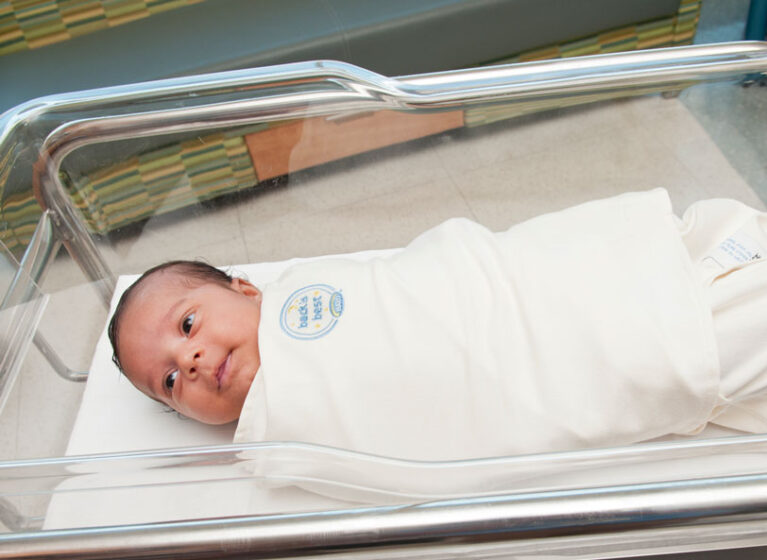
In June, the American Academy of Pediatrics (AAP) Task Force on Sudden Infant Death Syndrome released updated safe-sleep guidelines for the first time since 2016.
Two faculty at UVA Health — Rachel Y. Moon, MD, Harrison Distinguished Teaching Professor of Pediatrics, and Fern R. Hauck, MD, Spencer P. Bass, MD, Twenty-First Century Professor of Family Medicine and director of the International Family Medicine Clinic — are members of the task force. Moon, the chair, explains the motivation behind the updates as well as data points pediatricians should use to inform patient care.
Stalled Declines & New Data
In the 1990s, a national education campaign urging parents to have babies sleep on their backs led to a significant decline in fatalities. However, the annual number of deaths has not decreased since 2000. According to the AAP, about 3,500 sleep-related infant deaths still occur in the U.S. each year.
This plateau, as well as the emergence of new data, prompted the AAP to update the safe-sleep guidelines, Moon says. New research allowed for the addition of details about tummy time and breastfeeding. The updates also gave AAP the chance to remind the public about often-overlooked risks.
Tummy Time Timing
Previous guidance encouraged tummy time "but not when or for how long," Moon says. "Now there's evidence to show you should start with supervised tummy time immediately after coming back from the hospital and work up to 15 to 30 minutes a day by 7 weeks of life."
A Surprising Revelation About Breastfeeding
The benefits of breastfeeding for infants are well-established, but pediatricians may be surprised to learn about its positive impact on safe infant sleep.
According to the new guidelines, "2 months of … at least partial human milk feeding has been demonstrated to significantly lower the risk of sleep-related deaths." Furthermore, the AAP "recommends exclusive human milk feeding to 6 months, with continuation of human milk feeding for 1 year or longer as mutually desired by parent and infant."
Where Babies Should Sleep
In 2016, the AAP recommended using a "firm sleep surface" for infants. The new recommendations provide greater specificity on this point, including:
- Having children up to 1 year old sleep on their backs on "a firm, flat, non-inclined surface free of soft goods."
- Avoiding inclined surfaces such as "car seats, strollers, infant carriers, and infant slings" for routine sleeping
The 2022 guidelines also discourage the use of weighted blankets, which may compress babies' chests and make it harder for them to breathe.
Re-emphasizing the Dangers of Couches & Smoking
Some of the recommendations previously included in the guidelines have received more media coverage this time, says Moon. "Couches, sofas, and cushioned armchairs are dangerous places for babies to sleep," she adds. "It's incredibly important but hasn't gotten a lot of attention in the past."
The guidelines also provide a fresh perspective on certain topics. The perils of smoke and nicotine exposure during pregnancy and after birth, for instance, are well-known. But many pediatricians may not realize that the risk of sleep-related death is much higher for babies who are exposed to smoke.
One of the effects of nicotine is that it depresses a baby's ability to arouse, which is particularly important when babies are in a situation where they're not getting enough oxygen. This is probably why the risk of death is at least 10 times higher in infants who share the bed with a current smoker — even if the adult doesn't smoke in bed.
Confronting Racial & Ethnic Disparities
The safe-sleep guidelines report significant racial and ethnic disparities in sudden unexpected infant deaths. Compared with white infants, Black and American Indian/Alaska Native infants have, respectively, more than double and almost triple the risk of such deaths.
Moon encourages pediatricians to try to get at the root of why parents are making certain decisions. For example, parents may simply be misinformed about what constitutes safe infant sleep. Or they may turn to bedsharing because they can't afford a crib or live in a home with rodents. Cases like these present an opportunity for pediatricians to educate families and direct them to appropriate resources.
"These disparities may seem like more than pediatricians can handle on a day-to-day basis. But having those one-on-one conversations with each family can shed light on how you might be able to help them," she says. "If we all do that, we can chip away at some of these disparities."